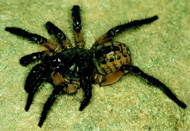Liphistius
| Liphistius | |
|---|---|

| |
| undetermined Liphistius species | |
| Scientific classification | |
| Domain: | Eukaryota |
| Kingdom: | Animalia |
| Phylum: | Arthropoda |
| Subphylum: | Chelicerata |
| Class: | Arachnida |
| Order: | Araneae |
| Suborder: | Mesothelae |
| Family: | Liphistiidae |
| Genus: | Liphistius Schiødte, 1849 |
| Species | |
|
See text | |
| Diversity | |
| 47 species | |
Liphistius is a genus of basal trapdoor spiders in the family Liphistiidae. They are found in Japan, China, and Southeast Asia.
Etymology
Liphistius is from the Greek Leipo (lacking) and stios (equality).[1]
Biology
Female body length ranges from 9 to 29 mm; males are slightly smaller. They live in burrows in earthen banks, on some cave walls, and probably in forests. The burrow is sealed with a thin, circular woven door, which is disguised with earth and moss. While they spend the day deep inside the burrow, at night they wait just below the door for insects, woodlice and similar animals that stumble over one of the seven silken threads that radiate from the entrance. With a reluctance to leave their burrows, they push up the door and reach for their prey.[2]
Species
- Liphistius albipes Schwendinger, 1995 — Thailand
- Liphistius batuensis Abraham, 1923 — Malaysia
- Liphistius bicoloripes Ono, 1988 — Thailand
- Liphistius birmanicus Thorell, 1897 — Myanmar
- Liphistius bristowei Platnick & Sedgwick, 1984 — Thailand
- Liphistius castaneus Schwendinger, 1995 — Thailand
- Liphistius dangrek Schwendinger, 1996 — Thailand
- Liphistius desultor Schiödte, 1849 — Malaysia; type species
- Liphistius endau Sedgwick & Platnick, 1987 — Malaysia
- Liphistius erawan Schwendinger, 1996 — Thailand
- Liphistius fuscus Schwendinger, 1995 — Thailand
- Liphistius isan Schwendinger, 1998 — Thailand
- Liphistius jarujini Ono, 1988 — Thailand
- Liphistius johore Platnick & Sedgwick, 1984 — Malaysia
- Liphistius kanthan Platnick, 1997 — Malaysia. IUCN Red List status = Critically Endangered.
- Liphistius lahu Schwendinger, 1998 — Thailand
- Liphistius langkawi Platnick & Sedgwick, 1984 — Malaysia
- Liphistius lannaianus Schwendinger, 1990 — Thailand
- Liphistius laoticus Schwendinger, 2013 -Laos
- Liphistius laruticus Schwendinger, 1997 — Malaysia
- Liphistius lordae Platnick & Sedgwick, 1984 — Myanmar
- Liphistius malayanus Abraham, 1923 — Malaysia
- Liphistius malayanus cameroni Haupt, 1983 — Malaysia
- Liphistius marginatus Schwendinger, 1990 — Thailand
- Liphistius murphyorum Platnick & Sedgwick, 1984 — Malaysia
- Liphistius nesioticus Schwendinger, 1996 — Thailand
- Liphistius niphanae Ono, 1988 — Thailand
- Liphistius ochraceus Ono & Schwendinger, 1990 — Thailand
- Liphistius onoi Schwendinger, 1996 — Thailand
- Liphistius ornatus Ono & Schwendinger, 1990 — Thailand
- Liphistius owadai Ono & Schwendinger, 1990 — Thailand
- Liphistius panching Platnick & Sedgwick, 1984 — Malaysia
- Liphistius phileion Schwendinger, 1998 — Thailand
- Liphistius phuketensis Schwendinger, 1998 — Thailand
- Liphistius priceae Schwendinger, 2017 — Malaysia
- Liphistius pusohm Schwendinger, 1996 — Thailand
- Liphistius rufipes Schwendinger, 1995 — Thailand, Malaysia
- Liphistius sayam Schwendinger, 1998 — Thailand
- Liphistius schwendingeri Ono, 1988 — Thailand
- Liphistius sumatranus Thorell, 1890 — Sumatra
- Liphistius suwat Schwendinger, 1996 — Thailand
- Liphistius tempurung Platnick, 1997 — Malaysia
- Liphistius tenuis Schwendinger, 1996 — Thailand
- Liphistius thaleban Schwendinger, 1990 — Thailand
- Liphistius thaleri Schwendinger, 2009 -Thailand
- Liphistius tham Sedgwick & Schwendinger, 1990 — Thailand
- Liphistius thoranie Schwendinger, 1996 — Thailand
- Liphistius tioman Platnick & Sedgwick, 1984 — Malaysia
- Liphistius trang Platnick & Sedgwick, 1984 — Thailand
- Liphistius yamasakii Ono, 1988 — Thailand
- Liphistius yangae Platnick & Sedgwick, 1984 — Malaysia
Footnotes
- ^ https://archive.org/stream/naturhistoriskti02krhe#page/620/mode/2up
- ^ Murphy & Murphy 2000
References
- Murphy, Frances & Murphy, John (2000): An Introduction to the Spiders of South East Asia. Malaysian Nature Society, Kuala Lumpur.
- Platnick, Norman I. (2008): The world spider catalog, version 8.5. American Museum of Natural History.
- Platnick, Norman I. & Sedgewick, W.C. (1984): A revision of the spider genus Liphistius (Araneae, Mesothelae). American Museum Novitates, (New York), No 2781, 31pp.
- Whitten, T., Clements, R. & Price, L. 2013. Liphistius kanthan. In: IUCN 2013. IUCN Red List of Threatened Species. Version 2013.1. <www.iucnredlist.org>. Downloaded on 6 July 2013.
